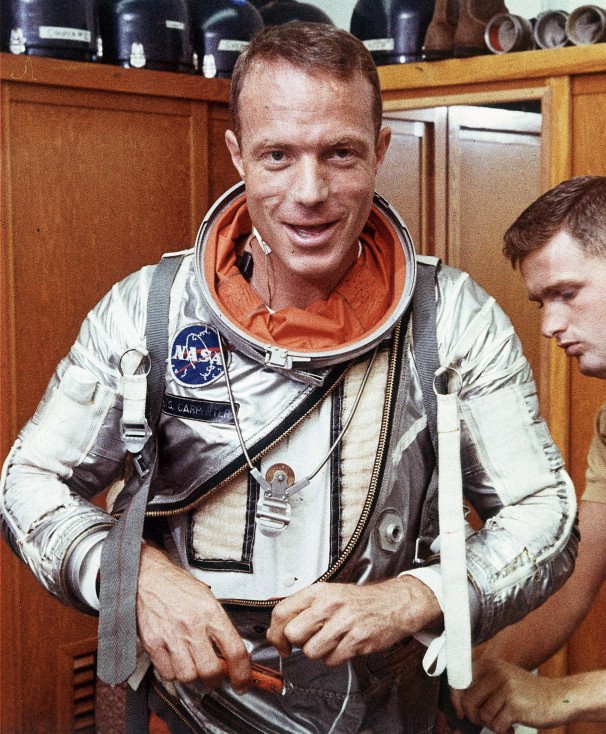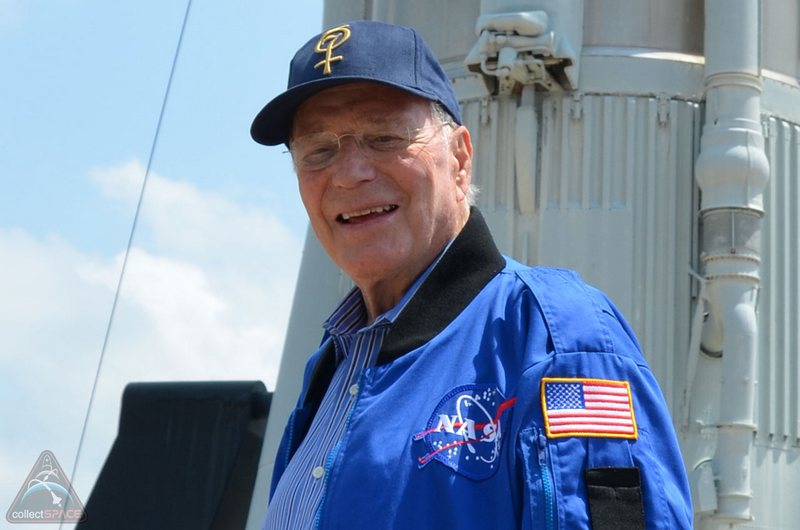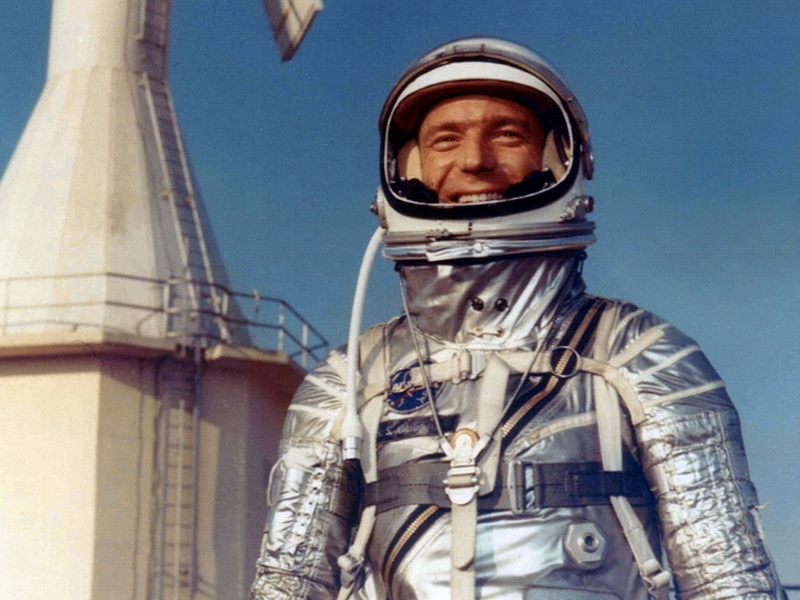Scott Carpenter (Scott Carpenter)

Born in Boulder, Colorado, Carpenter moved to New York City with his parents Marion Scott Carpenter and Florence [née Noxon] Carpenter for the first two years of his life. His father had been awarded a postdoctoral research post at Columbia University. In the summer of 1927, Scott returned to Boulder with his mother, then ill with tuberculosis. He was raised by his maternal grandparents in the family home at the corner of Aurora Avenue and Seventh Street, until his graduation from Boulder High School in 1943. (It was claimed that his reason for choosing the name ‘Aurora 7’ for his spacecraft was for the fact that he was raised at this house on the corner of Aurora and Seventh, but Carpenter denied this.)
Upon graduation, he was accepted into the V-12 Navy College Training Program as an aviation cadet (V-12a), where he trained until the end of World War II. The war ended before he was able to finish training and receive an overseas assignment, so the Navy released him from active duty. He returned to Boulder in November 1945 to study aeronautical engineering at the University of Colorado at Boulder. While at Colorado he joined Delta Tau Delta International Fraternity. At the end of his senior year, he missed the final examination in heat transfer, leaving him one requirement short of a degree. After his Mercury flight, the university granted him a B.S. degree on grounds that, “His subsequent training as an Astronaut has more than made up for the deficiency in the subject of heat transfer.”
On the eve of the Korean War, Carpenter was recruited by the United States Navy’s Direct Procurement Program (DPP), and reported to Naval Air Station Pensacola, Florida in the fall of 1949 for pre-flight and primary flight training. He earned his aviator wings on April 19, 1951, in Corpus Christi, Texas. During his first tour of duty, on his first deployment, Carpenter flew Lockheed P2V Neptunes for Patrol Squadron Six (VP-6) on reconnaissance and anti-submarine warfare (ASW) missions during the Korean War. Forward-based in Adak, Alaska, Carpenter then flew surveillance missions along the Soviet and Chinese coasts during his second deployment; designated as PPC (patrol plane commander) for his third deployment, LTJG Carpenter was based with his squadron in Guam.
Carpenter was then appointed to the United States Naval Test Pilot School, class 13, at NAS Patuxent River, Maryland in 1954. He continued at Patuxent until 1957, working as a test pilot in the Electronics Test Division; his next tour of duty was spent in Monterey, California, at the Navy Line School. In 1958, Carpenter was named Air Intelligence Officer for the USS Hornet.
After being chosen for Project Mercury in 1959, Carpenter, along with the other six astronauts, oversaw the development of the Mercury capsule. He served as backup pilot for John Glenn, who flew the first U.S. orbital mission aboard Friendship 7 in February 1962. Carpenter, serving as capsule communicator on this flight, can be heard saying “Godspeed, John Glenn” on the recording of Glenn’s liftoff. When Deke Slayton was withdrawn on medical grounds from Project Mercury’s second manned orbital flight (which Slayton would have named Delta 7), Carpenter was assigned to replace him. He flew into space on May 24, 1962, atop the Mercury-Atlas 7 rocket for a three-orbit science mission that lasted nearly five hours. His Aurora 7 spacecraft attained a maximum altitude of 164 miles (264 km) and an orbital velocity of 17,532 miles per hour (28,215 km/h).
Carpenter performed five onboard experiments per the flight plan, and became the first American astronaut to eat solid food in space. He also identified the mysterious “fireflies” observed by Glenn during Friendship 7 as particles of frozen liquid loosened from the outside of the spacecraft, which he could produce by rapping on the wall near the window. He renamed them “frostflies”. Carpenter’s performance in space was the subject of criticism and controversy. While one source has Christopher C. Kraft (Chris Kraft), directing the flight from Cape Canaveral, considering Carpenter’s “mission the most successful to date; everything had gone perfectly except for some overexpenditure of fuel.” The New York Times reported in its obituary for Carpenter that Kraft was angry because Carpenter was not paying attention to his instruments and ignoring instructions from Mission Control. Kraft opposed Carpenter’s assignment to future space missions.
At the retrofire event, the pitch horizon scanner malfunctioned once more, forcing Carpenter to manually control his reentry, which caused him to overshoot the planned splashdown point by 250 mi (400 km). (“The malfunction of the pitch horizon scanner circuit [a component of the automatic control system] dictated that the pilot manually control the spacecraft attitudes during this event.”) The PHS malfunction jerked the spacecraft off in yaw by 25 degrees to the right, accounting for 170 miles (270 km) of the overshoot; the delay caused by the automatic sequencer required Carpenter to fire the retrorockets manually. This effort took two pushes of the override button and accounted for another 15 to 20 miles (30 km) of the overshoot. The loss of thrust in the ripple pattern of the retros added another 60 miles (100 km), producing a 250-mile (400 km) overshoot.
During reentry, there was a great deal of concern over whether Carpenter had actually survived, since he splashed down 250 miles off course. Forty minutes after splashdown, Carpenter was located in his life raft, safe and in good health by Maj. Fred Brown under the command of the Puerto Rico Air National Guard, and recovered three hours later by the USS Intrepid. Postflight analysis described the PHS malfunction as “mission critical” but noted that the pilot “adequately compensated” for “this anomaly … in subsequent inflight procedures”, confirming that backup systems—human pilots—could succeed when automatic systems fail.
Some memoirs have revived the simmering controversy over who or what, exactly, was to blame for the overshoot, suggesting, for example, that Carpenter was distracted by the science and engineering experiments dictated by the flight plan and by the well-reported fireflies phenomenon. Yet fuel consumption and other aspects of the vehicle operation were, during Project Mercury, as much, if not more, the responsibility of the ground controllers. Moreover, hardware malfunctions went unidentified, while organizational tensions between the astronaut office and the flight controller office—tensions that NASA did not resolve until the later Gemini and Apollo programs—may account for much of the latter-day criticism of Carpenter’s performance during his flight.
Carpenter never flew another mission in space. After taking a leave of absence from the astronaut corps in the fall of 1963 to train for and participate in the Navy’s SEALAB program, Carpenter sustained a medically grounding injury to his left arm in a motorbike accident. After failing to regain mobility in his arm after two surgical interventions (in 1964 and 1967), Carpenter was ruled ineligible for spaceflight. He resigned from NASA in August 1967. He spent the last part of his NASA career developing underwater training to help astronauts with future spacewalks.
In July 1964 in Bermuda, Carpenter sustained a grounding injury from a motorbike accident while on leave from NASA to train for the Navy’s SEALAB project. In 1965, for SEALAB II, he spent 28 days living on the ocean floor off the coast of California. During the SEALAB II mission, Carpenter’s right index finger was wounded by the toxic spines of a scorpion fish. He returned to work at NASA as Executive Assistant to the Director of the Manned Spacecraft Center, then returned to the Navy’s Deep Submergence Systems Project in 1967, based in Bethesda, Maryland, as a Director of Aquanaut Operations for SEALAB III. In the aftermath of aquanaut Berry L. Cannon’s death while attempting to repair a leak in SEALAB III, Carpenter volunteered to dive down to SEALAB and help return it to the surface, although SEALAB was ultimately salvaged in a less hazardous way. Carpenter retired from the Navy in 1969, after which he founded Sea Sciences, Inc., a corporation for developing programs for utilizing ocean resources and improving environmental health.
Carpenter was married four times and divorced three. He married Rene Louise Price in 1948. In 1972, he married Maria Roach, daughter of film producer Hal Roach. He married Barbara Curtin in 1988 and divorced several years later. He married Patty Barrett in 1999. He had four children from his first marriage: Marc Scott, Kristen Elaine, Candace Noxon, and Robyn Jay. He also had two children from his second marriage: Matthew Scott and filmmaker Nicholas Andre, and one child from his third marriage, Zachary Scott. Carpenter had a stroke and entered The Denver Hospice Inpatient Care Center at Lowry where he died on October 10, 2013. He was 88 and was survived by his wife, Patty; four sons, Jay, Matthew, Nicholas, and Zachary; two daughters, Kristen Stoever and Candace Carpenter; a granddaughter; and five step-grandchildren. One son, Marc, predeceased him.
Born
- May, 01, 1925
- USA
- Boulder, Colorado
Died
- October, 10, 2013
- USA
- Denver, Colorado
Cemetery
- Carpenter Family Ranch
- Steamboat Springs, Colorado
- USA




